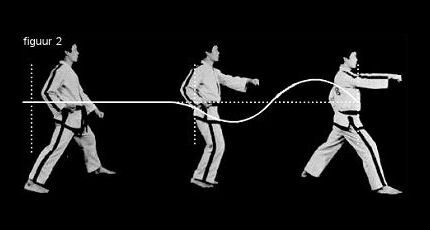 The Sine Wave (sinewave) motion is a movement unique to ITF Chang Hon-style Taekwon-do. It is named for the mathematical concept sine wave, an oscillating up-and-down motion. The intent in taekwondo is to create maximum power in one's technique by raising and lowering the body during the technique. This gives the Sine Wave style of taekwondo a very "bouncy" look and feel. This approach augments the relax-and-tense power principle of taekwondo. Note that not all ITF/Chang Hon-style schools adopt the Sine Wave.
The Sine Wave (sinewave) motion is a movement unique to ITF Chang Hon-style Taekwon-do. It is named for the mathematical concept sine wave, an oscillating up-and-down motion. The intent in taekwondo is to create maximum power in one's technique by raising and lowering the body during the technique. This gives the Sine Wave style of taekwondo a very "bouncy" look and feel. This approach augments the relax-and-tense power principle of taekwondo. Note that not all ITF/Chang Hon-style schools adopt the Sine Wave.
The basic motion of sinewave is "down-up-down." In other words there is usually a downward motion first, followed by an upward motion, and ending in a downward motion. Though the down-up-down motion is often illustrated in an exagerated way to make it clearer; in practice many schools teach that the motion should be slight, not exagerated.
Detail
There are variations on the down-up-down sinewave motion; these are related to the movement, combination, and speed of the techniques used.
The ITF Patterns (teul) exhibit five different "motions" that are part of the Sine Wave approach:
- Normal motion (1-1-1) - one full sinewave is completed during each breath. This is the normal method of movement and is assumed in patterns and exercises unless another is specified. It is therefore first used in the beginner exercises Saju-Jirugi and Saju-Makgi and the pattern Chon-Ji
- Continuous motion (2-2-1) - two sinewaves during one breath, as part of two consecutive movements. This is seen in the low block/rising block movements in Dan-Gun for example.
- Fast motion (2-2-2) - two movements are performed consecutively in fast speed, with two sinewave and two breaths. This is seen in the double punch in Do-San for example
- Connecting motion (2-1-1) - two movements are performed in one sinewave and one breath. An example of this is the hooking palm block/punch movements in Yul-Gok.
- Slow motion (1-1-1) - the movement is performed slowly, but according to the theory of power there has to be a slight acceleration at the end of the movement. There is one (slow) movement, one sinewave, in one breath. Slow motion techniques are meant to teach the student body control and balance. This is seen for example in the angle punch in Joong-Gun.
These five motions influence the sinewave, of which there are three variations:
- Full sine wave
- 2/3 sine wave
- 1/3 sine wave
Only in normal motion, continuous motion and slow motion there is a full sinewave (down-up-down).
- In fast motion there is 2/3 sinewave, as there is only an upward and downward movement. An example is found in Do-San: the two punches following movements 15-16 and 19-20.
- In connecting motion there is 1/3 sinewave, as there is only a downward movement. An example is found in Yul-Gok: the punch which follows movements 16-17 and 19-20.
| Basic Motions: | Variation: | Motion: | Breathing: | Movements: |
|---|---|---|---|---|
|
Full Sine Wave | down-up-down | one sine wave per breath | one |
|
Full Sine Wave | down-up-down | two sinewaves, one breath | two |
|
2/3 Sine Wave | up-down | two sinewaves in two breaths | two |
|
1/3 Sine Wave | down only | one sinewave, one breath | two |
|
Full Sine Wave | down-up-down | one sinewave, one breath | one (slow) |
Example
The following videos illustrate the Chang Hon form Chon-Ji in both Sine Wave and non-Sine Wave versions.
Why was this video chosen for use on this wiki? Do you have a better video? Please see Video Guidelines before replacing this video with a better one.
| Sine Wave | Non-Sine Wave |
|---|---|
History
Choi Hong Hi was advocating "knee flexing" as early as the 1970s. This was sometimes called "spring" style. In the early 1980s Choi expanded upon the concept and dubbed it Sine Wave. ITF/Chang Hon-style schools that do not incorporate Sine Wave will sometimes refer to themselves as "traditional" taekwondo, where the word "traditional" refers to "before Sine Wave."
